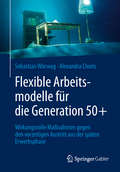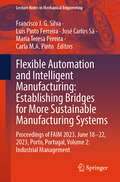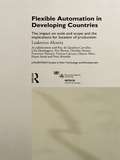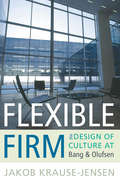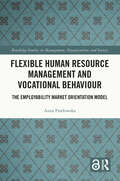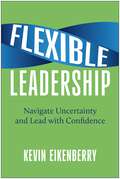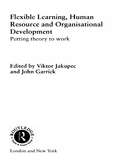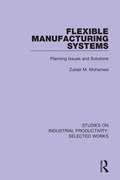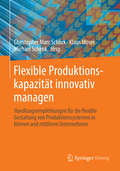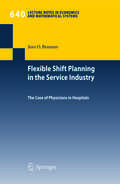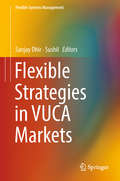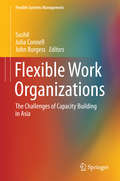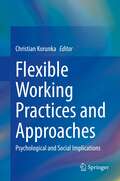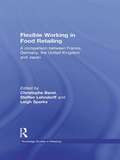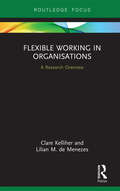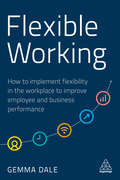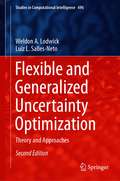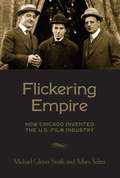- Table View
- List View
Flexible Arbeitsmodelle für die Generation 50+: Wirkungsvolle Maßnahmen gegen den vorzeitigen Austritt aus der späten Erwerbsphase
by Sebastian Wörwag Alexandra ClootsDieses Fachbuch präsentiert basierend auf den Ergebnissen einer breit abgestützten Studie flexible Arbeitsmodelle, die bei der Zielgruppe der Erwerbstätigen im Alter von über 50 Jahren zu einer Weiterbeschäftigung bis zum Rentenalter und darüber hinaus führen können. HR-Verantwortliche, Führungskräfte und interessierte Mitarbeitende erlernen Strategien, mit denen sie dem Fachkräftemangel wirksam entgegenwirken sowie zu Gesunderhaltung, Motivationssteigerung und verbesserter Arbeitsfähigkeit der Beschäftigten beitragen können. Ein systemisches Modell stellt die Einflussfaktoren nachhaltig guter Arbeit dar, ein Trendkapitel zeigt die künftigen Herausforderungen, und konkrete Flexibilisierungsmodelle sowie Fallstudien erleichtern die Umsetzung der Erkenntnisse in die Praxis.
Flexible Automation and Intelligent Manufacturing: Proceedings of FAIM 2023, June 18–22, 2023, Porto, Portugal, Volume 2: Industrial Management (Lecture Notes in Mechanical Engineering)
by Carla M. A. Pinto José Carlos Sá Francisco J. G. Silva Luís Pinto Ferreira Maria Teresa PereiraThis book reports on cutting-edge research and developments in manufacturing, giving a special emphasis to solutions fostering automation, sustainability and health, safety and well-being at work. Topics cover manufacturing process analysis and optimization, supply chain management, quality control, as well as human factors and logistics. They highlight the role and advantages of intelligent systems and technologies, discussing current best-practices and challenges to cope with in the near future. Based on proceedings of the 32nd edition of the International Conference on Flexible Automation and Intelligent Manufacturing, FAIM 2023, held on June 18–22, 2023, in Porto, Portugal, this second volume of a 2-volume set provides academics and professionals with extensive information on innovative strategies for industrial management in the era of industry 5.0.
Flexible Automation in Developing Countries: The impact on scale and scope and the implications for location of production (UNU/INTECH Studies in New Technology and Development)
by Ludovico AlcortaThis book examines the extent of, and motives for, the diffusion of flexible automation (FA) at global level and then turns to the local and firm level, bringing together in-depth studies of sixty-two firms in Brazil, India, Mexico, Thailand, Turkey and Venezuela. Research focuses on the impact of computer-numerically-controlled machine tools on scale and scope by exploring changes in lot sizes and product variety (product scale and scope), total plant output (plant scale) and total firm output (firm scale). Barriers to setting up FA-based operations are discussed, as are factors which may affect a decision to locate in a developing country. The contributed studies reveal a relatively slow diffusion of FA in developing countries and it is demonstrated that while FA possibly increases scope, it also requires that plant output be increased in order to maintain efficiency. Alcorta concludes that the location in developing countries will probably only be viable for large domestic firms, multinationals seeking to relocate simple but labour intensive assembly processes and firms in countries with significant domestic markets. This work is unique in addressing the scale and scope issues in developing countries and in the wealth of information regarding machine tools which it provides. The data provided in the appendix includes official United Nations data, previously unpublished. This will be of use for all research into trends in the use of machine tools.
Flexible Compensation and Benefits: Why Variety Will Rule and How to Leverage It
by Ken Dychtwald Tamara J. Erickson Robert MorisonCompensation and benefits should work for employees and for the business-as levers with which the company can meet employee needs, enable their productivity, and improve their performance. This chapter addresses the challenge of managing compensation and benefits and getting all the facets of the deal "right."
Flexible Firm: The Design of Culture at Bang & Olufsen
by Jakob Krause-JensenBang & Olufsen, the famous Danish producer of high-end home electronics, is well known as an early exponent of value-based management: the idea that there should be consistency in what the organisation does, a certain continuity between what the company develops and sells, and the beliefs and practices of the employees. This study investigates how company values are communicated and the collective identity is articulated through the use of such concepts as 'culture', 'fundamental values', and 'corporate religion', as well as how employees negotiate these ideas in their daily working lives. As this book reveals, the identification of values, meant to create cohesion and solidarity among employees, came to symbolise and engender a split between the staff and the other parts of the company. By examining the rise and fall of the value-based management approach, this volume offers the indispensible insight of anthropological enquiry to expose how social realities challenge conventional management strategies and therefore must be considered in the development of new management techniques.
Flexible Human Resource Management and Vocational Behaviour: The Employability Market Orientation Model (Routledge Studies in Management, Organizations and Society)
by Anna PawłowskaThe Employability Market Orientation (EMO) model, which is more extensive than traditional approaches in the field of personal marketing, along with a questionnaire for its measurement, makes the employee "anti-fragile" behaving as a micro-entrepreneur (workpreneur). It achieves high levels of employability and marketability and low job insecurity. This attitude has consequences for employers such as low employee loyalty and commitment. Thus, HR specialists will be able to develop adequate solutions and methods reducing the effects of retention. The EMO questionnaire contained in the book will allow them to diagnose such attitudes. This book guides readers through the world of the rules of the contemporary labor market with the end of life-long employment, encouraging to have proactive attitude by both the employee and the employer. Its originality lies in the fact that it focuses on employees who can be adopted, not being victims of flexible human resource management. It is written in an objective manner, supported by reliable research with advanced statistical analysis, and will be of value to researchers of management, the labor market, career counselling, sociologists and work psychologists. Proposed indicators of often imprecise concepts such as mobility and professional flexibility are explored. These concepts will help scholars to conduct research on new phenomena and develop theories of modern organization with disappearing borders and transactional relations.
Flexible Human Resource Management and Vocational Behaviour: The Employability Market Orientation Model (Routledge Studies in Management, Organizations and Society)
by Anna PawłowskaThe Employability Market Orientation (EMO) model, which is more extensive than traditional approaches in the field of personal marketing, along with a questionnaire for its measurement, makes the employee "anti-fragile" behaving as a micro-entrepreneur (workpreneur). It achieves high levels of employability and marketability and low job insecurity. This attitude has consequences for employers such as low employee loyalty and commitment. Thus, HR specialists will be able to develop adequate solutions and methods reducing the effects of retention. The EMO questionnaire contained in the book will allow them to diagnose such attitudes.This book guides readers through the world of the rules of the contemporary labor market with the end of life-long employment, encouraging to have a proactive attitude by both the employee and the employer. Its originality lies in the fact that it focuses on employees who can be adopted, not being victims of flexible human resource management. It is written in an objective manner, supported by reliable research with advanced statistical analysis, and will be of value to researchers of management, the labor market, career counselling, sociologists and work psychologists. Proposed indicators of often imprecise concepts such as mobility and professional flexibility are explored. These concepts will help scholars to conduct research on new phenomena and develop theories of modern organization with disappearing borders and transactional relations.
Flexible Leadership: Navigate Uncertainty and Lead with Confidence
by Kevin EikenberryBecome a more flexible leader in today&’s unpredictable world with a revolutionary approach to applying leadership skills—while remaining steadfast in proven principles and your values.Despite the billions of dollars invested every year into leadership development, leaders aren&’t collectively becoming more successful. Existing tools like assessments, models, and styles have proven largely inadequate in equipping leaders for today&’s age of work. For leaders to succeed in a landscape more unpredictable than ever, they need a new perspective and a brand-new set of skills that center around what is missing in the models and existing tools: flexibility. Kevin Eikenberry, Chief Potential Officer of the Kevin Eikenberry Group, a leadership consulting company centered on a philosophy of lifelong learning, explains the need for and how to effectively harness this essential flexibility in this guide for leaders at all levels. A roadmap outlining a new toolkit for leaders frustrated with their current effectiveness and confidence, Flexible Leadership teaches readers to: Distinguish between what has and hasn&’t changed in the world of work—enabling them to lead with greater success and leverage flexibility more effectively Efficiently use, but not rely on, existing and familiar leadership models Apply a framework to be more situationally flexible and effective every day without compromising their values The flexible leader has a clear mindset and increased confidence knowing that they can respond to their everyday situations with greater success, instead of being overly reliant on restrictive and complicated tools that can get in the way. Flexible Leadership is every leader&’s guide to greater success in a world of increasing complexity and chaos.
Flexible Learning Opportunities: Why Continuous Education Matters and How to Make It Pay Off
by Ken Dychtwald Tamara J. Erickson Robert MorisonLearning is integral to an organization's capability and productivity, recruiting and retention, and leadership and capacity for change, but with the coming shortage of skills and labor, learning also becomes a business performance imperative. In this chapter, the authors provide the tools necessary for building a learning organization, and address diverse learning opportunities for the three worker cohorts.
Flexible Learning, Human Resource and Organisational Development: Putting Theory to Work
by Viktor Jakupec John GarrickRecent challenges facing higher and tertiary education such as the impact of globalisation and the emergence of new technologies, have called for a radical reconceptualisation of the teaching-learning nexus.This book addresses contemporary contexts of flexible learning and its practices, and provides insights about directions in which education and
Flexible Manufacturing Systems: Planning Issues and Solutions (Studies on Industrial Productivity: Selected Works #5)
by Zubair M. MohamedOriginally published in 1994 this book undertakes a comprehensive study dealing with the effects of machine flexibility, tool magazine capacity, varying production demands and different oeprating policies on the production planning problems. Performance measures such as FMS flexibility, makespan and inventory are used in evaluating the effects. Three measures of FMS flexibility - actual routing flexibility, potential routing flexibility and capacity flexibility are defined and operationalized.
Flexible Plankostenrechnung und Deckungsbeitragsrechnung
by Kurt Vikas Jochen R. Pampel Wolfgang KilgerMit der 13. Auflage der "Flexiblen Plankostenrechnung und Deckungsbeitragsrechnung" wird der zukunftsweisende Weg Wolfgang Kilgers für praxisgerechtes Kosten- und Erlösmanagement konsequent weiter geführt. Vollständig aktualisiert bietet dieses Standardwerk den State-of-the-Art einer modernen Plankosten- und Deckungsbeitragsrechnung. Ohne die bewährte Grundstruktur zu verändern, gehen Kurt Vikas und Jochen Pampel auf alle wichtigen aktuellen Entwicklungen ein. Schwerpunkte der Überarbeitung: Die Aufnahme neuester relevanter Entwicklungen im Rechnungswesen und Controlling aus Unternehmenspraxis und Theorie in der Einführung; die Herauslösung des bewährten Modellbetriebes aus dem laufenden Text und komprimierte Darstellung und Erläuterung des Zahlenflusses in einem eigenen Kapitel; die Übernahme des von Kurt Vikas entwickelten, geschlossenen und abstimmfähigen Zahlenmodells für eine Grenzplankosten- und Deckungsbeitragsrechnung "QUATTRO" zur Abrundung der Lehrbuchfunktion sowie die geänderten Anforderungen durch neue Rechnungslegungsvorschriften.
Flexible Produktionskapazität innovativ managen: Handlungsempfehlungen für die flexible Gestaltung von Produktionssystemen in kleinen und mittleren Unternehmen
by Christopher Marc Schlick, Klaus Moser and Michael SchenkDer flexible Einsatz von Mitarbeitern/-innen in produzierenden Unternehmen adressiert ein Thema von hoher wirtschaftlicher Bedeutung und Aktualität. Gestaltungsmöglichkeiten werden im Hinblick auf Produktionssysteme wie auch in Bezug auf den Einsatz der Personalressourcen behandelt. Produktionsplaner und Personalleitung erhalten konkrete Handlungsempfehlungen.Dieser praxisorientierte Handlungsleitfaden spricht insbesondere kleine und mittelständische Unternehmen an. "FlexPro - Flexible Produktionskapazität innovativ managen" war ein Forschungsprojekt in Unternehmen, dessen Ergebnisse als Grundlage dieses Leitfadens anschaulich erläutert werden.
Flexible Shift Planning in the Service Industry
by Jens O. BrunnerThe book presents new ideas to model and solve the flexible shift planning problem of personnel workers in the service industry. First, a new modeling approach is proposed that requires shifts to be generated implicitly rather than employing a predefined set of shift types like three 8-hour or two 12-hour shifts to cover varying forecast demand. The objective is to minimize the total cost of the assignments given the general and individual labor restrictions. Second, to find high quality assignments two solution methodologies are presented. A heuristic decomposition strategy decomposes the problem into weekly subproblems whereas a branch-and-price algorithm that uses several branching rules decomposes the model by worker types. The master problem uses a set covering formulation whereas the subproblems are mixed integer programs. The modeling and solution methodologies are developed and tested using the example of physicians from an anesthesia department of a German university hospital.
Flexible Strategies in VUCA Markets (Flexible Systems Management)
by Sushil Sanjay DhirThis book discusses the concepts of volatility, uncertainty, complexity, and ambiguity (VUCA) that are the core of various paradigms used in strategic management to understand competitive advantage as well as flexibility in organizational boundaries. It serves as a valuable reference resource in the area of VUCA markets. An increase in the levels and types of uncertainty has important implications potentially for the durability of a company’s advantages, the way firms learn and adapt, approaches for managing innovation and knowledge, and the attractiveness of different strategies and organizational models. In today’s world, strategic flexibility in VUCA is essential for business leaders to sustain market advantage and attain a clear vision amid the chaos. Business leaders who stay focused and are aware of external volatility as the prevalent characteristic are successful, while those who are not flexible in this VUCA world and lock themselves into fixed positions lose out.The book includes empirical and conceptual research papers along with case studies and models discussing strategies for emerging markets in volatile and uncertain environments. It also covers a variety of issues, including innovation, people and processes, financial management, and leadership and strategies in VUCA markets. Apart from research fraternity and academia, the contents of the book will be useful for practitioners as well as industry watchers.
Flexible Work Arrangements: Why You Need Them Now and How to Make Them Work
by Ken Dychtwald Tamara J. Erickson Robert MorisonOver-all, 17 percent of employees are currently seeking a more flexible schedule, and 14 percent want to work more from home-which is why today's corporations should begin changing their employment deal now to implement flexible work arrangements. This chapter is an introduction to this process.
Flexible Work Organizations
by Sushil Julia Connell John BurgessThis book focuses on the challenges of capacity building for flexible work organizations in Asia, and demonstrates how business enterprises practice reactive flexible capacity (in the form of adaptiveness and responsiveness) to cope with changing and uncertain business environments. The book provides examples of how this can be achieved by means of various organizational change initiatives, leadership strategies, re-engineering, innovation in products and processes, the use of information and communication technology, reshaping learning orientations, and more. As these topics are supported by research and case studies situated in different sectors and countries across Asia, the book will provide a useful resource for a broad readership including: management students and researchers, practicing business managers, consultants, and professional institutions.
Flexible Working Practices and Approaches: Psychological and Social Implications
by Christian KorunkaModern workplaces are following a strong trend of increasing flexible working practices and approaches, offering more flexibility in working times, working places, work organization, and work relations as the result of new information and communication technologies. This book brings together a group of internationally recognized experts in the field of flexible work to examine the psychological and social implications of these practices, describing the current state of research and empirically-based practices in this field. It focuses on organizational, job, and individual factors related to the quality of working life, and identifies potential risk groups where the benefits of flexible work are suppressed or not realized.Ideal for organizations implementing or considering implementing flexible work, for professionals and researchers in work and organizational psychology, and for HR professionals, this volume is an invaluable overview of rapidly changing work norms and their impact on working life.
Flexible Working in Food Retailing: A Comparison Between France, Germany, Great Britain and Japan (Routledge Studies in Retailing)
by Leigh Sparks Steffen Lehndorff Christophe BaretThis book makes use of a four country research programme, covering France, Germany, Great Britain and Japan. Investigations and interviews at store, company and individual levels paint a picture of working times in the sector and in each of the countries. The volume provides some explanations for national differences as well as the similarities; supply and demand issues, as well as societal and social backgrounds. Large format food retailing is a major force in each country, employing millions in many different situations and conditions. This book suggests opportunities for retailers and employees to better manage their situations.
Flexible Working in Organisations: A Research Overview (State of the Art in Business Research)
by Clare Kelliher Lilian M. de MenezesThere is growing interest in flexible working, not only as a means to manage labour more efficiently and for greater agility, but also as a response to increasing concerns over well-being, work-life balance, and participation in the labour force of those with significant non-work commitments (e.g. parents, carers, older workers). As a result, a comprehensive stream of literature on the benefits and challenges of flexible working has developed and led to a body of evidence on the implementation and outcomes of different forms of flexible working arrangements. This book assesses the current state of this literature as follows: Background: the authors review the different definitions that have been proposed, policy developments, availability and uptake. Outcomes from flexible working: the main chapters focus on the outcomes for employers (e.g. performance, employee retention, organisational commitment etc.), as well as for individual employees (e.g. well-being, job satisfaction etc.). Evaluation of extant knowledge: the authors comment on the existing literature and consider the methodological approaches adopted in the literature. Conclusion: suggestions for future research are proposed. Of interest to students, academics and policy-makers, this book provides an expert overview of the empirical evidence and offers critical commentary on the state of knowledge in the field of flexible working and new forms of work.
Flexible Working: How to Implement Flexibility in the Workplace to Improve Employee and Business Performance
by Gemma DaleFlexible working is now a key concern for many employees. It spans genders, ages and family circumstances, with 37% of millennials declining a job offer if working flexibly isn't an option and 78% of employees over 50 wanting more flexible hours. Flexible Working is a practical guide for HR practitioners showing how to develop an effective flexible working strategy to meet the needs of employees and the needs of the business. This book explains how to develop effective flexibility policies and processes as well as how to communicate and train line managers on these practices. It also includes advice on how to overcome barriers to flexible working, dispels common myths and offers guidance on the different forms of flexible working available to organizations.Flexible Working shows that working practices outside the standard 9-5, five-days-a-week in the office can benefit a company. It drives employee engagement and performance, reduces costs and workplace stress and improves talent acquisition from a more diverse talent pool. It also explains how a proactive flexible working strategy can have sustainability benefits and reduce a company's carbon footprint. Including case studies from organizations such as Zurich Insurance, and supported by rigorous analysis of flexible working data, this is essential reading for all HR professionals.
Flexible and Generalized Uncertainty Optimization: Theory and Approaches (Studies in Computational Intelligence #696)
by Weldon A. Lodwick Luiz L. Salles-NetoThis book presents the theory and methods of flexible and generalized uncertainty optimization. Particularly, it describes the theory of generalized uncertainty in the context of optimization modeling. The book starts with an overview of flexible and generalized uncertainty optimization. It covers uncertainties that are both associated with lack of information and are more general than stochastic theory, where well-defined distributions are assumed. Starting from families of distributions that are enclosed by upper and lower functions, the book presents construction methods for obtaining flexible and generalized uncertainty input data that can be used in a flexible and generalized uncertainty optimization model. It then describes the development of the associated optimization model in detail. Written for graduate students and professionals in the broad field of optimization and operations research, this second edition has been revised and extended to include more worked examples and a section on interval multi-objective mini-max regret theory along with its solution method.
Flextronics International, Ltd.
by Gary P. Pisano Robert S. HuckmanDescribes Flextronics' evolution from providing outsourced manufacturing services for original equipment manufacturers (OEMs) in the electronics industry to developing entire unbranded products for purchase by OEMs. In 2001, Flextronics began a development program that yielded several unbranded cell phones that--even by the admission of several OEMs--delivered performance comparable to that of branded products at a significantly lower cost. Nonetheless, as of early 2003, no major OEM had yet agreed to purchase any of these phones from Flextronics. As chairman and CEO of Flextronics, Michael Marks must decide how aggressively to pursue full product development.
Flextronics: Deciding on a Shop Floor System for Producing the Microsoft Xbox
by Alison Berkley Wagonfeld Jeffrey T. PolzerJim McCusker must guide a group decision-making process aimed at getting input and buy-in from key people in California, Mexico, and Austria to choose a shop floor IT system for Flextronics. McCusker is Flextronics' account manager for the Microsoft Xbox project. Geographical distance and time pressure make it difficult for all the relevant parties to assemble in person in one location. In a company culture that values fast, decisive action, McCusker wonders whether he has the authority to make the decision himself and, if not, how he should involve the other parties who are keenly interested in the outcome.
Flickering Empire: How Chicago Invented the U.S. Film Industry
by Adam Selzer Michael Glover SmithTells the fascinating but too little known story of how Chicago served as the unlikely capital of film production in America in the years prior to the rise of Hollywood (1907-1913)
